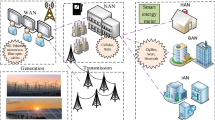Abstract
This paper focuses on the allocation of resources to cognitive users in a two-way cognitive radio facilitated smart grid (SG) network. The resources are essential in controlling the performance of demand response management in the SG, ensuring profit to the power supplier and simultaneously cost-saving to the consumers. However, cognitive users need more power for their data transmission, which compels the utility company to increase its electricity price. Hence, we propose an adaptive resource allocation algorithm based on normalized least mean squares (NLMS) to estimate the electricity price that benefits both the supplier and consumers with optimal allocation of power demands under the constraints of transmission power, system throughput, and the probability of detection. The simulation results validate the performance of our proposed scheme by comparing it with the application of metaheuristic algorithms for maximizing aggregate profit. The impact of the channel parameters on system performance is also studied.







Similar content being viewed by others
References
Ma, R.; Chen, H.H.; Huang, Y.R.; Meng, W.: Smart grid communication: its challenges and opportunities. IEEE Trans. Smart Grid IEEE 4(1), 36–46, 2013
Sharma, K.; Saini, L.M.: Performance analysis of smart metering for smart grid: an overview. Renew. Sustain. Energy Rev. Elsevier 49, 720–735, 2015
Erol-Kantarci, M.; Mouftah, H.T.: Energy-efficient information and communication infrastructures in the smart grid: A survey on interactions and open issues. IEEE Commun. Surv. Tutorials IEEE 17(1), 179–197, 2014
Emmanuel, M.; Rayudu, R.: Communication technologies for smart grid applications: a survey. J. Netw. Comput. Appl. Elsevier 74, 133–148, 2016
Zhang, K.; Mao, Y.; Leng, S.; Bogucka, H.; Gjessing, S.; Zhang, Y.: Cooperation for optimal demand response in cognitive radio enabled smart grid. In: 2016 IEEE International Conference on Communications (ICC), IEEE (2016)
Deng, R.; Chen, J.; Cao, X.; Zhang, Y.; Maharjan, S.; Gjessing, S.: Sensing-performance tradeoff in cognitive radio enabled smart grid. IEEE Trans. Smart Grid IEEE 4(1), 302–310, 2013
Yu, R.; Zhang, C.; Zhang, X.; Zhou, L.; Yang, K.: Hybrid spectrum access in cognitive-radio-based smart-grid communications systems. IEEE Syst. J. IEEE 8(2), 577–587, 2013
Yang, C.; Fu, Y.; Yang, J.: Optimisation of sensing time and transmission time in cognitive radio-based smart grid networks. Int. J. Electron. Taylor Francis 103(7), 1098–1111, 2016
Liu, P.; Ma, K.; Yang, J.; Yang, B.; Liu, Z.; Guan, X.: Joint interference management and power allocation for relay-assisted smart grid communications. IEEE Internet Things J. (2019)
Cacciapuoti, A.S.; Caleffi, M.; Paura, L.: On the probabilistic deployment of smart grid networks in TV white space. Sens. Multidiscip. Digit. Publ. Inst. 16(5), 671, 2016
Li, Q.; Feng, Z.; Li, W.; Gulliver, T.A.; Zhang, P.: Joint spatial and temporal spectrum sharing for demand response management in cognitive radio enabled smart grid. IEEE Trans. Smart Grid IEEE 5(4), 1993–2001, 2014
Hsiao, W.-L.; Chiu, W.-Y.: Spectrum sensing control for enabling cognitive radio based smart grid. In: 2016 2nd International Conference on Intelligent Green Building and Smart Grid (IGBSG), IEEE (2016)
Haris, M.; Jangsher, S.; Qureshi, H.K.; Mumtaz, S.; Dulaimi, A.A.: Power allocation for reliable smart grid communication employing neighborhood area networks. In: 2018 IEEE Global Communications Conference (GLOBECOM), IEEE (2018)
Li, Y.; Wang, Z.; Luo, L.; Chen, Z.; Xia, B.; Luo, H.: Bandwidth allocation of cognitive relay networks with energy harvesting for smart grid. J. Comput. Netw. Commun. Hindawi 2019 (2019)
Ogbodo, E.U.; Dorrell, D.G.; Abu-Mahfouz, A.M.: Performance measurements of communication access technologies and improved cognitive radio model for smart grid communication. Trans. Emerg. Telecommun. Technol. Wiley Online Lib. 30(10), 3653, 2019
Khan, M.W.; Zeeshan, M.: QoS-based dynamic channel selection algorithm for cognitive radio based smart grid communication network. Ad Hoc Netw. Elsevier 87, 61–75, 2019
Samadi, P.; Mohsenian-Rad, A.; Schober, R.; Wong, V.W.S.; Jatskevich, J.: Optimal real-time pricing algorithm based on utility maximization for smart grid. In: 2010 First IEEE International Conference on Smart Grid Communications, IEEE (2010)
Liang, Y.; Zeng, Y.; Peh, E.C.Y.; Hoang, A.T.: Sensing-throughput tradeoff for cognitive radio networks. IEEE Trans. Wirel. Commun. 7(4), 1326–1337, 2008
Lopes, P.A.C.; Gerald, J.B.: New normalized LMS algorithms based on the Kalman filter. In: 2007 IEEE International Symposium on Circuits and Systems, IEEE (2007)
López, R.B.; Sánchez, S.M.; Fernandez, E.M.G.; Souza, R.D.; Alves, H.: Genetic algorithm aided transmit power control in cognitive radio networks. In: 2014 9th International Conference on Cognitive Radio Oriented Wireless Networks and Communications (CROWNCOM), Oulu (2014)
You, Z.; Chen, W.; He, G.; Nan, X.: Adaptive weight particle swarm optimization algorithm with constriction factor. In: 2010 International Conference of Information Science and Management Engineering, Xi'an (2010)
Author information
Authors and Affiliations
Corresponding author
Appendix I
Appendix I
Proof of \(B_{nt}\) is a concave function of \(d_{nt}\) at a constant \(P_{tnt}\).
Proof
Taking the first derivative of Eq. (11) for a constant value of \(P_{tnt}\).
It is known that if the Hessian matrix \(H\left( {B_{nt} } \right)\) is negative, \(B_{nt}\) is concave in \(d_{nt}\). Taking the second derivative of Eq. (11) w.r.t \(d_{nt}\)
Hence, diagonal elements of \(H\left( {B_{nt} } \right)\) are negative and other elements are zero. It shows that \(B_{nt}\) is strictly concave in \(d_{nt}\).
Rights and permissions
About this article
Cite this article
Das, D., Khadanga, R.K. Adaptive Price Estimation in Cognitive Radio Enabled Smart Grid Networks. Arab J Sci Eng 46, 1451–1463 (2021). https://doi.org/10.1007/s13369-020-05154-6
Received:
Accepted:
Published:
Issue Date:
DOI: https://doi.org/10.1007/s13369-020-05154-6




